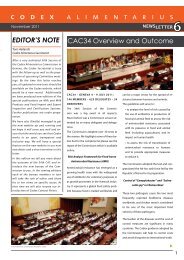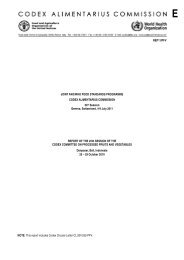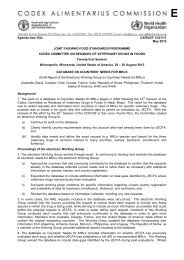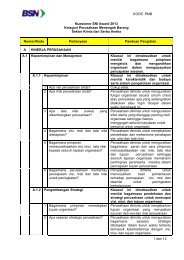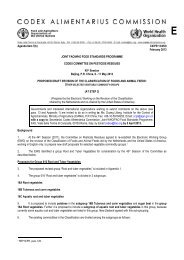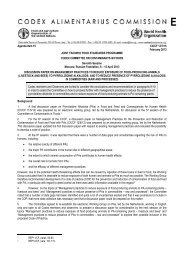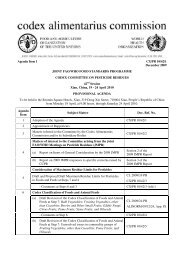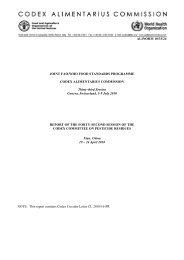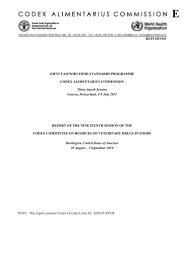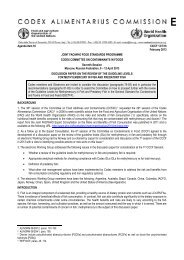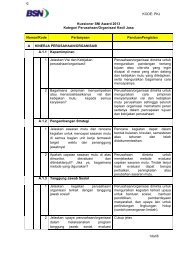alinorm 10/33/41 - CODEX Alimentarius
alinorm 10/33/41 - CODEX Alimentarius
alinorm 10/33/41 - CODEX Alimentarius
You also want an ePaper? Increase the reach of your titles
YUMPU automatically turns print PDFs into web optimized ePapers that Google loves.
ALINORM <strong>10</strong>/<strong>33</strong>/<strong>41</strong>44APPENDIX III16. The fruit should preferably be de-stoned.17. If the fruits are not de-stoned and/or the residues of fruits (marc) are used for preparing mash, they shouldbe mashed gently avoiding the crushing of stones. If possible, stones should be removed from the mash.FERMENTATION18. Selected yeast preparations for the production of spirit drinks should be added to the mashed fruits,according to the manufacture’s instructions for users, for a fast and “clean” fermentation.19. Mashed fermented fruits should be handled with high standards of hygiene, and exposure to light should beminimised. Fermented fruit mashes containing stones should be stored as briefly as possible before distillationsince hydrocyanic acid may also be released from intact stones during prolonged storage..20. If the mash is prepared by macerating stone fruit into alcoholic beverages, the stone fruit should beremoved soon after the aroma of stone fruit is adequately extracted.DISTILLATION EQUIPMENT21. Distillation equipment and the distillation process should be suitable, to ensure that hydrocyanic acid is nottransferred into the distillate(a)(b)Use of a copper still will limit carryover of ethyl carbamate–forming precursors into the distillate.Use of a stainless steel condenser rather than a copper condenser will limit presence of copper in thedistillate, where copper can promote formation of ethyl carbamate.22. The distillation equipment should preferably include automatic rinsing devices and copper catalyticconverters. The automatic rinsing devices will keep the copper stills cleaned while the copper catalytic converterswill bind hydrocyanic acid before it passes into the distillate.23. Automatic rinsing devices are not necessary in the case of discontinuous distillation. The distillationequipment should be cleaned by systematic and thorough cleaning procedures.24. When copper catalytic converters or other dedicated cyanide separators are not available, copper(I) chloridecan be added to the fermented fruit mash before distillation. The purpose of these copper (I) ions is to bindhydrocyanic acid. Copper (II) ions should not be used.DISTILLATION PROCESS25. Stones settled in the fermented mash should not be pumped into the distillation device.26. Distillation should be carried out in such a way that alcohol is boiled off slowly and in a controlled matter(e.g. by using steam instead of a direct flame as the heating source).27. The first fractions of the distillate, called ‘heads’, should be separated carefully.28. The middle fraction, called ‘hearts’, should then be collected and should be stored in the dark. When thealcohol content reaches 50 % vol. in the receiver, collection should be switched to the ‘tails’, so that any ethylcarbamate that may have been formed is separated in the tail fraction.29. Some manufacturers may redistill the separated tails, possibly containing ethyl carbamate. If the tails areused for re-distilling, they should be re-distilled separately, however for reduction of ethyl carbamateconcentration it is preferable to discard the tail.



